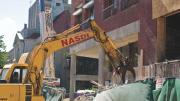A gut renovation of the Sherman Fairchild building this fall will yield 62,000 square feet of space for 275 investigators dedicated to stem-cell research, including faculty members, graduate students, technicians, postdoctoral fellows, and research assistants. The high-density open labs--211 net square feet per work station--are part of a design philosophy intended to foster collaboration that carries over from the unbuilt Allston science complex. When the $65-million to $70-million project is complete in the fall of 2011, there will be 16 faculty investigators engaged in stem-cell and regenerative biology in Cambridge here and in the adjacent Bauer Laboratory.
Harvard renovates building to create new labs for stem-cell research
Harvard renovates building to create new labs for stem-cell research
Harvard renews an older building to create new labs in Cambridge for stem-cell research.

You might also like
Trump Administration Appeals Order Restoring $2.7 Billion in Funding to Harvard
The appeal, which had been expected, came two days before the deadline to file.
At Harvard, AI Meets “Post-Neoliberalism”
Experts debate whether markets alone should govern tech in the U.S.
Sam Liss to Head Harvard’s Office for Technology Development
Technology licensing and corporate partnerships are an important source of revenue for the University.
Most popular
Explore More From Current Issue

Open Book: A New Nuclear Age
Harvard historian Serhii Plokhy’s latest book looks at the rising danger of a new arms race.

This TikTok Artist Combines Monsters and Mental Heath
Ava Jinying Salzman’s artwork helps people process difficult feelings.

Harvard’s Financial Challenges Lead to Difficult Choices
The University faces the consequences of the Trump administration—and its own bureaucracy





